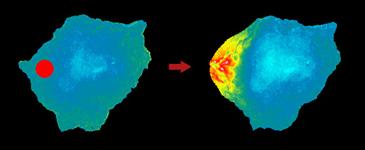Controlling Cells with Light
Researchers at the University of North Carolina in Chapel Hill and the Max Planck Institute in Heidelberg, Germany have genetically engineered animal cells to make proteins that can be turned on and off using visible light.

indicated by the red dot, activating a hybrid version of a
protein called Rac and causing the cell to change shape
and move. Credit: Yi Wu, UNC-Chapel Hill
The researchers spliced a gene for a light-activated protein with the gene for a protein called Rac, which is known to be involved in regulating healthy cell movements as well as the movement of cancer cells. Researchers then focused laser light to locally activate the proteins, causing protrusions that led to cell movement. The work was described this week in the journal Nature.
The location of a protein within the cell plays a role in determining the cell’s behaviors, but this has been difficult to study. The researchers hope using light activation will be a good method.
Here’s how it works: the light-activated portion of the protein blocks the binding site on Rac. When it’s illuminated, the block is removed and Rac can function. A second pulse of light at a different wavelength causes the block to move back into position, deactivating the protein.
The technique should be compatible with other proteins in addition to Rac. In the past, researchers have made proteins that are activated by ultraviolet radiation, which is toxic to cells. And these previous proteins couldn’t be turned off again; the new ones can.
Keep Reading
Most Popular
Large language models can do jaw-dropping things. But nobody knows exactly why.
And that's a problem. Figuring it out is one of the biggest scientific puzzles of our time and a crucial step towards controlling more powerful future models.
The problem with plug-in hybrids? Their drivers.
Plug-in hybrids are often sold as a transition to EVs, but new data from Europe shows we’re still underestimating the emissions they produce.
Google DeepMind’s new generative model makes Super Mario–like games from scratch
Genie learns how to control games by watching hours and hours of video. It could help train next-gen robots too.
How scientists traced a mysterious covid case back to six toilets
When wastewater surveillance turns into a hunt for a single infected individual, the ethics get tricky.
Stay connected
Get the latest updates from
MIT Technology Review
Discover special offers, top stories, upcoming events, and more.